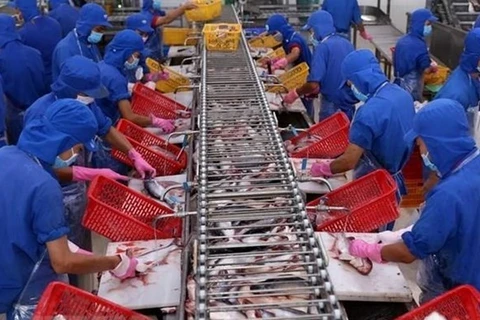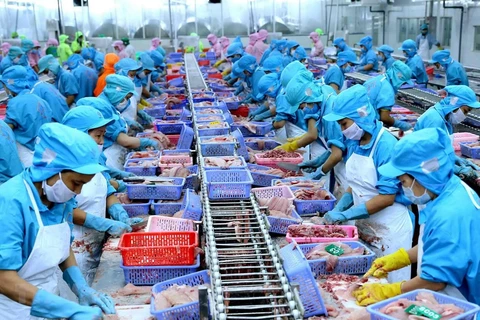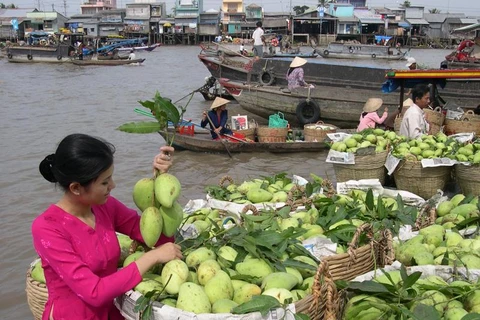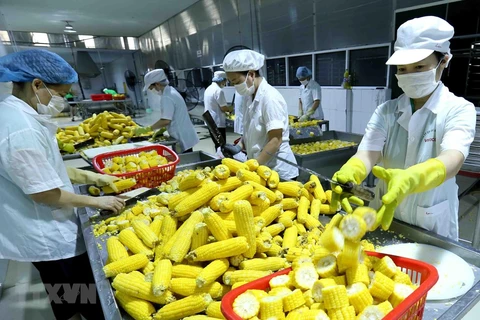Hanoi (VNS/VNA) - This year is believed to be a brighter year for the domestic tra fish industry with exports inching up in the first quarter, according to an official from the Vietnam Pangasius Association.
Duong Nghia Quoc, chairman of the association, said this month the US was scheduled to issue final results in the 15th period of review (POR15) with lower anti-dumping duties on frozen tra fish (pangasius) fillets against POR14.
The Food Safety and Inspection Service (FSIS) under the US Department of Agriculture officially recognised Vietnam's Pangasius Food Safety Control System in November 2019 after more than three years of negotiations.
Quoc was quoted by vietnambiz.vn as saying that "those are considered good signals to recover pangasius exports to the US market. However, according to domestic enterprises, the recovery will not be strong this year.”
China, another key export market of Vietnam’s tra fish, was likely to increase demand for Vietnamese tra fish this year and beyond, he said.
At present, Vietnam is experiencing difficulties in exporting seafood as well as other farm produce to China due to the coronavirus epidemic, according to the Ministry of Agriculture and Rural Development.
However, in the long term, the potential for boosting exports of tra fish to China is still great because consumption per capita is still low at 0.14 kilo per year, while consumption in the US is 0.32 kilo per person a year, according to Doan Toi, Chairman of the Board of Directors and General Director of Nam Viet Group.
With these positive signs, domestic tra fish exports were expected to increase this year, Quoc said. However, the industry would still face competition globally.
China has raised pangasius, while it has promoted control of quality for tra fish exported from Vietnam.
Meanwhile, some countries such as India, Thailand, Bangladesh and Indonesia have also raised pangasius. The total output of these countries is likely to reach the same level of Vietnam.
Quoc said local businesses needed to enhance trade promotion, expand markets and apply technology for production to improve quality.
Especially, the local business community needed cooperation to develop production chains and avoid competition to reduce prices, he said.
In addition, they also had a big chance to promote the consumption of pangasius in the domestic market, Quoc said. Some years ago, the tra fish producers sold their product in the domestic market. However, due to the huge profit from exports, the domestic market was ignored.
At present, with a population of 100 million, they could consume 200,000 tonnes of tra fish every year if each person eats two kilos of tra fish per year, Quoc said.
To develop the domestic market, the pangasius industry would need a strong distribution channel. The State should have incentives for local businesses to increase domestic tra fish consumption. At the same time, the businesses must also boost trade promotion to bring more tra fish products to local customers, Quoc said.
According to the Vietnam Association of Seafood Exporters and Producers (VASEP), in 2019, Vietnam gained 2 billion USD from tra fish exports, down 11.7 percent compared to 2018.
The reduction was due to difficulties in exports to traditional markets, like the US, and the plunge in export prices.
Pangasius exports to the US market dropped sharply by 49 percent last year to 282 million USD. This export value accounted for 14 percent of Vietnam's pangasius export value, much lower than the tra fish export value to China, accounting for 32 percent of the total.
Moreover, in 2019, farmers increased acreage of rearing tra fish due to high profit in the 2017-2018, so Vietnam had oversupply of tra fish last year while import demand fell on the world market. As a result, Vietnam’s tra fish export price last year dropped by 30-35 percent compared to 2018./.
Duong Nghia Quoc, chairman of the association, said this month the US was scheduled to issue final results in the 15th period of review (POR15) with lower anti-dumping duties on frozen tra fish (pangasius) fillets against POR14.
The Food Safety and Inspection Service (FSIS) under the US Department of Agriculture officially recognised Vietnam's Pangasius Food Safety Control System in November 2019 after more than three years of negotiations.
Quoc was quoted by vietnambiz.vn as saying that "those are considered good signals to recover pangasius exports to the US market. However, according to domestic enterprises, the recovery will not be strong this year.”
China, another key export market of Vietnam’s tra fish, was likely to increase demand for Vietnamese tra fish this year and beyond, he said.
At present, Vietnam is experiencing difficulties in exporting seafood as well as other farm produce to China due to the coronavirus epidemic, according to the Ministry of Agriculture and Rural Development.
However, in the long term, the potential for boosting exports of tra fish to China is still great because consumption per capita is still low at 0.14 kilo per year, while consumption in the US is 0.32 kilo per person a year, according to Doan Toi, Chairman of the Board of Directors and General Director of Nam Viet Group.
With these positive signs, domestic tra fish exports were expected to increase this year, Quoc said. However, the industry would still face competition globally.
China has raised pangasius, while it has promoted control of quality for tra fish exported from Vietnam.
Meanwhile, some countries such as India, Thailand, Bangladesh and Indonesia have also raised pangasius. The total output of these countries is likely to reach the same level of Vietnam.
Quoc said local businesses needed to enhance trade promotion, expand markets and apply technology for production to improve quality.
Especially, the local business community needed cooperation to develop production chains and avoid competition to reduce prices, he said.
In addition, they also had a big chance to promote the consumption of pangasius in the domestic market, Quoc said. Some years ago, the tra fish producers sold their product in the domestic market. However, due to the huge profit from exports, the domestic market was ignored.
At present, with a population of 100 million, they could consume 200,000 tonnes of tra fish every year if each person eats two kilos of tra fish per year, Quoc said.
To develop the domestic market, the pangasius industry would need a strong distribution channel. The State should have incentives for local businesses to increase domestic tra fish consumption. At the same time, the businesses must also boost trade promotion to bring more tra fish products to local customers, Quoc said.
According to the Vietnam Association of Seafood Exporters and Producers (VASEP), in 2019, Vietnam gained 2 billion USD from tra fish exports, down 11.7 percent compared to 2018.
The reduction was due to difficulties in exports to traditional markets, like the US, and the plunge in export prices.
Pangasius exports to the US market dropped sharply by 49 percent last year to 282 million USD. This export value accounted for 14 percent of Vietnam's pangasius export value, much lower than the tra fish export value to China, accounting for 32 percent of the total.
Moreover, in 2019, farmers increased acreage of rearing tra fish due to high profit in the 2017-2018, so Vietnam had oversupply of tra fish last year while import demand fell on the world market. As a result, Vietnam’s tra fish export price last year dropped by 30-35 percent compared to 2018./.
VNA
























